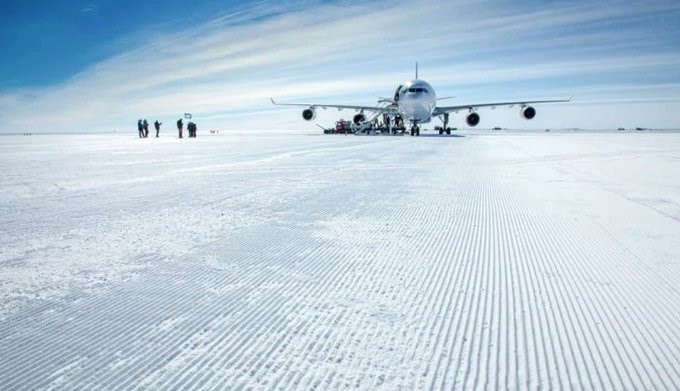[Watch] For The First Time, An Airbus A340 Lands In Antarctica

New Delhi: On November 2, at 8.19 am local time, an Airbus A340-313 took off from Cape Town, South Africa. Airbus A340s have been flying to all corners of the globe for nearly 30 years now.
But this A340 flight was different. It was destined for Wolf’s Fang, a place 2,500 nautical miles away in Antarctica. Never before an A340 had landed in Antarctica.
Just to list a few challenges, there are no runways at Wolf’s Fang, only miles of “blue glacial ice”. Pilots have to deal with a phenomenon known as “whiteout”. Magnetic heading doesn’t work near the poles. Navigation is done by flying ‘True’ heading (We will come to that later). Moreover, there are no electronic landing aids at Wolf’s Fang.
After a five-hour flight, Hi Fly 801, Captain Carlos Mirpuri in command, the A340 touched down smoothly on the White Continent’s “blue glacial ice runway”. In the cockpit, the crew exchanged handshakes and smiles. For the first time in history, an A340 had landed in Antarctica.
THE FLIGHT
The flight was conducted by Hi Fly, an aviation company specialising in wet leases, which means it offers aircraft and crew on hire. The round trip on November 2 was a preparatory flight for Hi Fly’s plan to fly a small number of tourists, scientists and cargo to Antarctica in the coming months.
Besides crew members, it carried 23 passengers, ground equipment that would be needed in Antarctica and sufficient fuel to cover the round trip as there are no refuelling facilities at Wolf’s Fang.
The takeoff from Cape Town was scheduled for 8 am local time; 5 hours 10 minutes for the onward leg, 5 hours 20 minutes for the return leg and 3-hour turnaround time.
After a 19-minute delay, the A340 was finally airborne. “We lined up on runway 01 but had to pause for a moment before launching; I spotted intense bird activity over the runway… eventually they moved out of the way. The last thing we want is a bird strike and potential engine damage on any flight. At 8:19 am we were finally airborne,” Mirpuri, who is also the vice-president of Hi Fly, writes in his log.
THE CHALLENGES
The crew lost data link communication with ground 250 miles before Wolf’s Fang. But around 180 miles from destination, they could re-establish ground communication via VHF.
“The guys at WFR (Wolf’s Fang Runway) have an Iridium Satphone, the only means to communicate from that part of the globe,” Mirpuri writes.
The crew was also worried about the weather at destination. A specially equipped car passed on runway friction data — ice actually – to the crew. Special equipment was used to cut grooves on the 3,000-metre runway for effective braking. As the plane was loaded with fuel for the return trip also, the touchdown would be at maximum landing weight of 190 tons.
FLYING IN A MILK BOTTLE
“The reflection is tremendous… and the blending of the runway with the surrounding terrain and the immense white desert around, makes height judgment challenging, to say the least,” Mirpuri notes in his log.
A phenomenon known as “whiteout”, it’s well-known to polar pilots. Sunlight refracted through ice crystals turns the sky white and the snow and sky merge seamlessly, making it impossible to separate sky from earth.
On November 28, 1979, in such ‘whiteout’ conditions, coupled with navigational errors before departure, Air New Zealand Flight 901, which had taken off on a sightseeing flight over the Antarctic, crashed into Mt Erebus on a bright, clear day, killing all 237 passengers and 20 crew members onboard.
‘Flying in a milk bottle’ is an expression used to describe ‘whiteout’ conditions.
POLAR NAVIGATION
Wolf’s Fang is located at a latitude of about 71° south. Beyond 65° south, flight crews use ‘True’ heading for navigation, not ‘Magnetic’ heading.
Just to expand the point, when we say ‘True’ North, it’s the Earth’s geographical North Pole. And Magnetic North is the Earth’s magnetic field. A magnetic compass points to this direction. True North is located in the middle of the Arctic Ocean. Magnetic North right now is on Ellesmere Island in Northern Canada and shifting.
The magnetic compass becomes unreliable near the poles for navigation.
ANTARCTIC FLIGHTS
In 1928, Australian explorer Sir Hubert Wilkins flew a Lockheed Vega monoplane to Antarctica but crashed after a short flight. But it was Richard Byrd who became the first man to overfly the South Pole in 1929.
In 1955, the US Navy’s VXE-6 Antarctic Development Squadron was established. The US and a host of other countries operated ferry flights to McMurdo Sound.
Air New Zealand and Australia’s Qantas operated sightseeing flights over Antarctica for years till the crash of Flight 901.

Comments are closed.